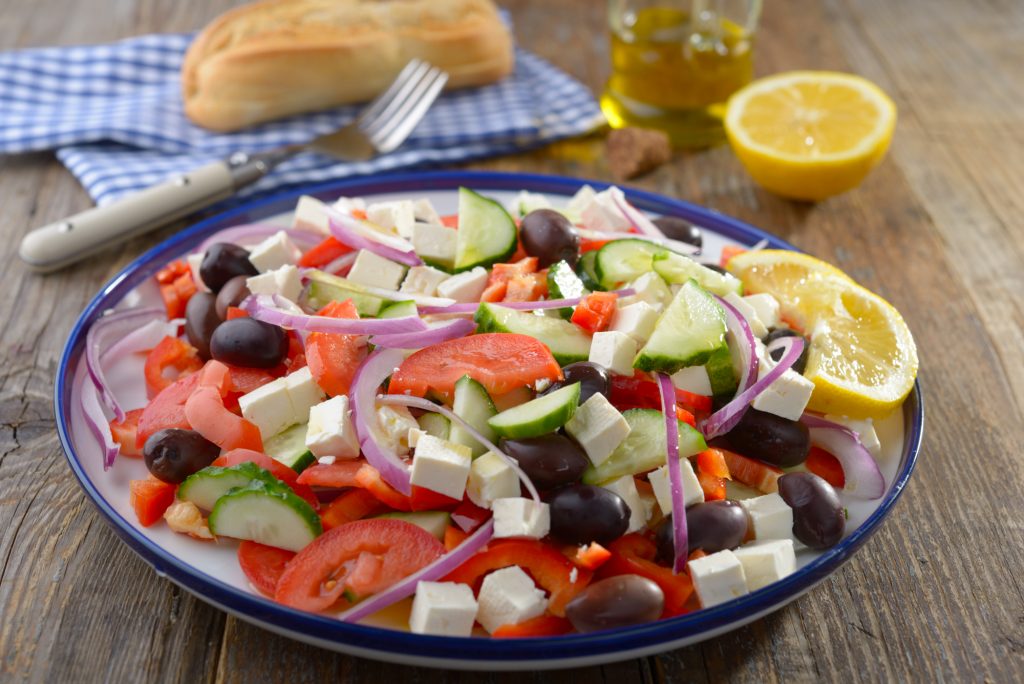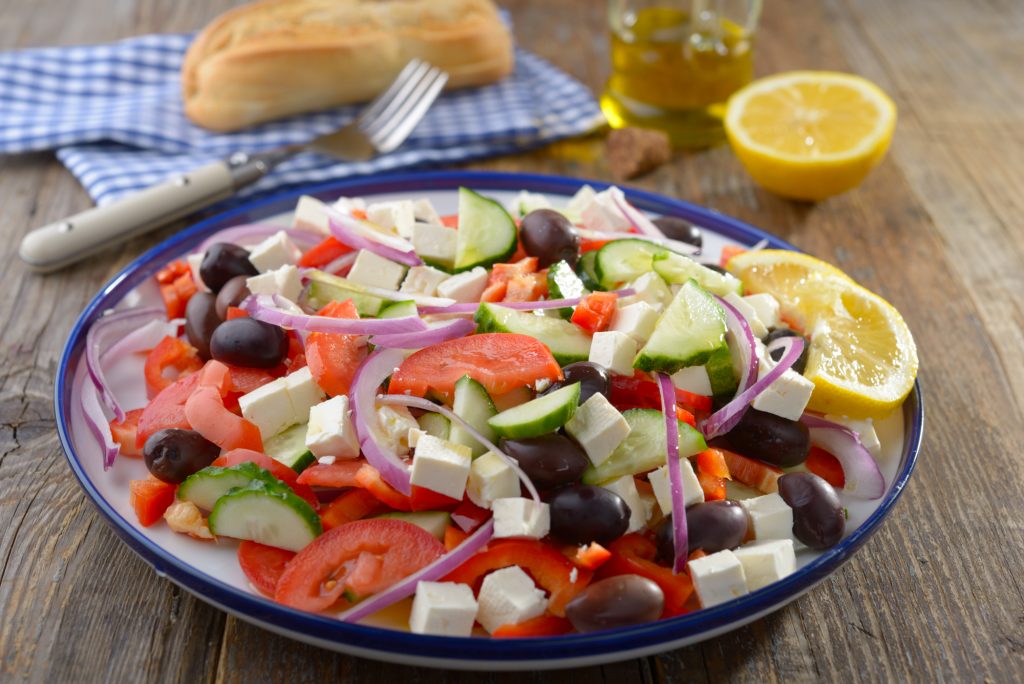
Greek Horiatiki Salad with Olive Oil, Tomatoes, Feta Cheese
Share
Crisp, colorful, and refreshingly simple, the Greek salad—known in Greece as Horiatiki—is a staple of Mediterranean cuisine. Made with vine-ripened tomatoes, crunchy cucumbers, briny olives, and creamy feta cheese, it celebrates the flavors of fresh, seasonal ingredients in the most rustic way.
This traditional Greek salad contains no lettuce and requires no complex dressing—just a drizzle of extra virgin olive oil and a sprinkle of dried oregano. Whether served as a light lunch, a side dish to grilled meats, or part of a larger mezze spread, Horiatiki salad captures the soul of Greek cooking: honest, vibrant, and rooted in the land.
Greek Salad (Horiatiki) Ingredients
The secret to an authentic Greek salad (Horiatiki) lies in its simplicity and the quality of its ingredients. A true traditional Greek salad recipe uses only a handful of seasonal, fresh components—each contributing bold flavor and vibrant texture.

Greek Salad with olive oil Argilos I
Core Greek Salad Ingredients:
- Tomatoes: Use ripe, juicy tomatoes cut into wedges or large chunks. In Greece, summer heirloom or vine-ripened tomatoes are ideal.
- Cucumbers: Sliced or chopped Persian or English cucumbers add cool crunch. Peel partially if the skin is thick or bitter.
- Red Onion: Thinly sliced raw red onion gives the salad its signature sharpness. Soak slices briefly in cold water to mellow the flavor if preferred.
- Green Bell Pepper: Optional but traditional, thinly sliced green bell peppers provide earthiness and color.
- Kalamata Olives: Whole, unpitted Kalamata olives are the classic choice. Their deep, briny flavor is essential to the dish.
- Feta Cheese (Block Style): Authentic Greek salad features a slab of feta, not crumbled. Use sheep’s milk feta packed in brine for the best taste and texture.
- Extra Virgin Olive Oil: Drizzled generously over the top—no other dressing is needed. Choose a high-quality Greek olive oil for true Mediterranean flavor.
- Dried Oregano: A sprinkle of dried Greek oregano adds an herbal finish and enhances the salad’s aroma.
Optional Additions (Regional or Personal Variations):
- Capers – Used in island recipes for an extra punch of salinity.
- Red wine vinegar – Occasionally added for acidity.
- Crusty bread or paximadia – Serve on the side or crumbled in as part of a Cretan-style dakos variation.
How to Make a Traditional Greek Salad
Making a traditional Greek salad (Horiatiki) is incredibly simple, yet every detail matters when you’re working with raw, fresh ingredients. There’s no creamy dressing or lettuce here—just bold, rustic flavors that speak for themselves. Follow this step-by-step Greek salad preparation guide to achieve authentic results.

Step 1: Chop the Vegetables
Roughly chop ripe tomatoes into wedges or chunks. Slice cucumbers into thick half-moons. Thinly slice red onions and green bell peppers (if using). Keep the pieces large and rustic—this is a village-style salad.
Step 2: Layer, Don’t Toss
Place the vegetables in a shallow bowl or platter, starting with tomatoes and cucumbers, then layering the onion, pepper, and Kalamata olives. Do not toss—Greek salad is built in layers for presentation and texture.
Step 3: Add the Feta Block
Top the salad with a slab of feta cheese, not crumbled. Traditional Greek salad always features feta in block form, usually placed in the center.
Step 4: Drizzle and Season
Drizzle generously with extra virgin olive oil—no vinegar or dressing needed. Sprinkle with dried oregano and a pinch of sea salt (optional, as feta and olives add saltiness).
Step 5: Serve Immediately
Greek salad is best served fresh. No need to chill or marinate. Serve with crusty bread to soak up the tomato-olive oil juices.
Dishes Served with Greek Salad
A Greek salad (Horiatiki) is versatile and pairs beautifully with a wide range of Mediterranean dishes. Whether you're serving it as a light main course or as part of a larger spread, here are some of the best Greek salad meal ideas and side dish pairings to complete your plate.

1. Grilled Meats and Seafood
Greek salad makes the perfect fresh contrast to grilled lamb chops, chicken souvlaki, pork gyros, or grilled fish like sea bass or sardines. The acidity from the tomatoes and lemony olive oil balances the richness of the meat.
2. Pita Bread and Dips
Serve with warm pita bread and traditional Greek dips like tzatziki, hummus, or melitzanosalata (eggplant dip) for a full mezze-style experience.
3. Moussaka or Pastitsio
As a cooling side dish, Greek salad complements hearty baked dishes like moussaka or pastitsio. The salad’s freshness helps lighten these rich, layered mains.
4. Spanakopita or Tiropita
Pair your Greek salad with spanakopita (spinach pie) or tiropita (cheese pie) for a classic vegetarian Greek lunch or appetizer platter.
5. Rice, Quinoa, or Lentils
For a healthy and balanced meal, serve Greek salad with a base of brown rice, quinoa, or lentils. It turns the dish into a complete and nutrient-packed bowl.
6. Mediterranean Mezze Platter
Combine Greek salad with olives, dolmades (stuffed grape leaves), feta cheese, and roasted vegetables to create a vibrant Mediterranean mezze platter ideal for entertaining.
Frequently Asked Questions (FAQs)
1. Is Greek salad healthy?
Yes, Greek salad is a healthy, low-carb dish rich in antioxidants, fiber, and healthy fats. Made with fresh vegetables, olives, and extra virgin olive oil, it’s a staple of the Mediterranean diet and suitable for vegetarian, gluten-free, and keto-friendly meals (if served without bread).
2. What cheese is used in Greek salad?
Traditional Greek salad uses a block of feta cheese, typically made from sheep’s milk and stored in brine. Authentic recipes do not use crumbled feta—a thick slice is placed on top of the salad and drizzled with olive oil and oregano.
3. Can I make Greek salad ahead of time?
Yes, you can prep Greek salad in advance, but for the best texture and flavor, assemble it just before serving. You can chop the vegetables and store them separately, then combine with feta and olive oil right before eating to prevent sogginess.
4. How long does Greek salad last in the fridge?
Once assembled, Greek salad lasts 1 to 2 days in the refrigerator. The tomatoes and cucumbers may release water over time, so it's best to consume fresh or within 24 hours for optimal taste and texture.
5. What’s the best olive oil for Greek salad?
Use high-quality extra virgin olive oil, preferably from Greece, for authentic flavor. Look for cold-pressed oils with a fruity or peppery profile to complement the salad’s ingredients.














